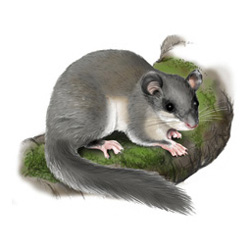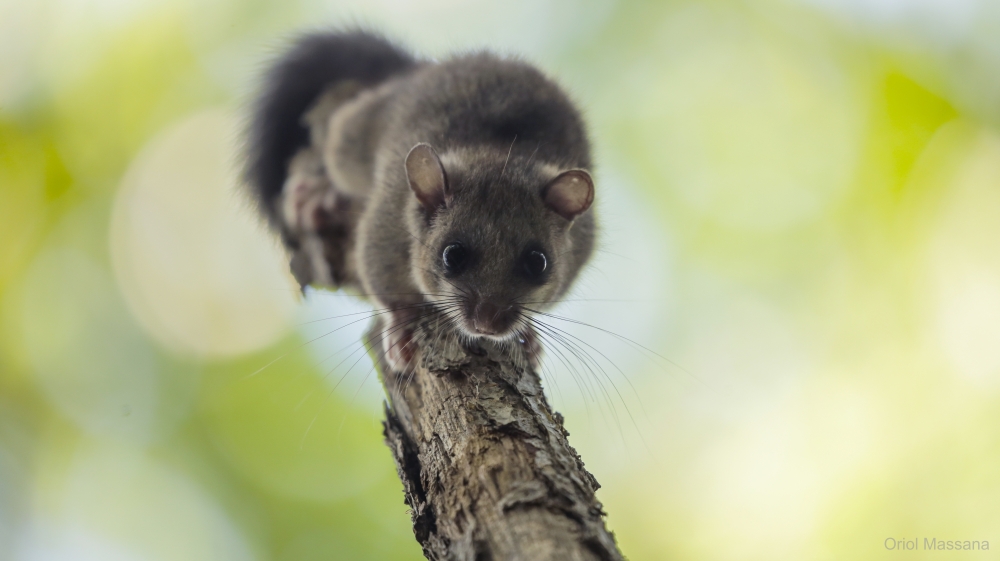Edible dormouse

Glis glis Linnaeus, 1766
Gliridae
| Other names | |
|---|---|
| Catalan | Liró gris |
| Spanish | Lirón gris |
| English | Edible dormouse |
| French | Loir gris |
| Basque | Muxar grisa |
| Galician | Rilón |
Description
It is the largest species of its family (Gliridae) and the only one of its genus, Glis. It is a robust and compact animal, with a body length varying between 13 and 19 cm and a weigh between 70 and 200 grams (adults). The coat is dense and soft, with a bright grey colour on the back, which mixes with darker and browner tones as the animal gets older. The belly is completely white and becomes dirtier in the flanks with age. It has a peculiar tail, which can reach up to 13 cm in length and is covered with long grey hairs. The thick black eyes are surrounded by a small circle of black hairs. It is an arboreal, nocturnal animal and one of the few hibernating rodents found in Europe. It is a long-lived species (up to 12 years) considering its small size.
Furthermore, it can be found frequently occupying nest boxes, an occupation that depends on the availability of natural cavities, the density of individuals in the area and the annual breeding activity. Individuals usually occupy the boxes from July to November, to mate, breed, accumulate food or to take refuge and rest during the day, alone or in groups. Boxes are not used for hibernation.
Fotografies
The map shows the UTM 10x10 squares in which the species has been detected either at monitoring stations or through punctual sightings.
Distribution
It has a European distribution that coincides with the area dominated by deciduous forests of the western Palearctic zone. It is found in eastern, central, and southeastern Europe, except Denmark, the Atlantic coast of the Netherlands and France. Its eastern boundary is marked by the Volga River, and it reaches as far north as Iran. It is absent from the Scandinavian peninsula. It is found in 19 islands, including Sicily, Corsica, Sardinia, Crete and Corfu. Since the beginning of the 20th century, there has been a small population in England, where it was introduced. In the Iberian Peninsula, its presence is concentrated in the northern strip, from Catalonia to Galicia, passing through the Iberian and Cantabrian systems, among others. In Catalonia it is distributed in the Pyrenees, Pre-Pyrenees, and the humid eastern region in the domains of typical deciduous forests such as beech, humid oak, and hazelnut groves. The most northeastern Catalan populations are found in the Albera massif and the southernmost in the Prelitoral and Litoral mountain ranges, which are also the most southern populations of the entire Iberian Peninsula, specifically in the Montnegre massif.
Habitat and feeding
The species has Central European requirements and is adapted to deciduous forest. It prefers mature forests and mixed beech and oak forests with natural cavities and fruit-bearing trees, which can be accompanied by species such as hazel, chestnut, ash, birch and walnut, among others. It also occurs in riparian forests with the presence of these species. A minimum presence of undergrowth is favourable because it offers food supplements such as red fruits. The presence of rocks, cavities, dry stone walls and even some ruined buildings within its territory provide protection and shelter during hibernation. It is a species with a wide altitudinal range, approximately 50 to 2,000 meters above sea level throughout its European distribution area.
Feeding
Breeding
Generally, it breeds once a year, although in years of low food availability it might not breed. Sexual maturity is usually reached after the first hibernation, but they do not always come into oestrus in the first year. They are considered adults after the second hibernation. The length of the mating season varies according to the geographical area, being shorter in central and northern Europe (from the end of June to the beginning of July), while in more Mediterranean areas it goes from mid-June to mid-August. Gestation lasts about 25 - 30 days. In Catalonia, the Pyrenean populations, unlike the most southern ones (Montnegre massif), have a rather central European behaviour, with a shorter and earlier breeding period (early August to early September). Instead, the coastal populations show a longer period (mid-August to early October). They might have up to 12 pups per litter, although the average is 4-6 pups per female. Lactating females can group together during breeding and share brood nests. They nest in tree hollows and fill them with tender green leaves that they cut with their teeth from the canopy. Gestation lasts about 21 days and lactation lasts one month. Females reach sexual maturity at 6 to 7 weeks of age, and males at 7 to 8 weeks. The number of offspring can range from 1 to 12, but most often 7. The average lifespan of the species is rarely more than one year (typical of species with a high turnover rate).
